It’s such a thrill to see wild Alaskan animals in their natural habitat. At a distance. Hiking the open spaces and wild backcountry and forested islands of Alaska allowed us to see many of them. Here are a few photos taken of the animals we spotted in the parks and preserves. Included are some facts learned about the animals.
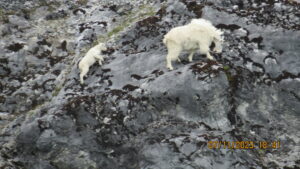
Alaska has three species of bear: black, brown, and polar. The Kodiak or grizzly bear is of the brown bear species. Black and brown bear have various shades. Look for the shoulder hump for the grizzly or brown bear, the more aggressive bear species. Back bears are the smallest, so I was glad we only spotted those bears foraging for berries and insects along grassy mountainsides. Unfortunately, we couldn’t get clear photos. Just black blobs.
Never run from a bear. They are faster. Always. Bear can climb trees, especially black bear. And all three species of bear can swim much better than humans.
With all our bushwhacking in Alaska, we needed to shout before moving forward in a thickly forested area. We didn’t want to surprise any bears. We stayed in a group to look bigger to the bear. If you encounter a bear, raise your arms, flap your coat. Look taller than you are. And back away—slowly.
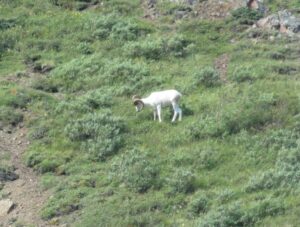
Alaska Dall sheep have horns that continue to grow and curl in spring, summer, and early fall. Dalls don’t shed their horns. The more massive and curled the horns, the older the sheep.
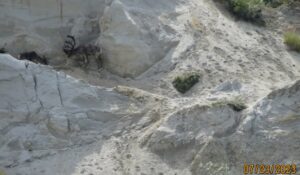
Caribou have huge antlers. Caribou and reindeer are the same species, we learned from guides. We found some caribou grazing along a rocky mountain ledge.
We even found moose crossing a park road in a forested area of Alaska. Moose are the largest member of the deer family. The female we photographed has twins, which meant food had been plentiful. Usually, females have only one offspring.

But all wild animals need their space. Humans should not engage with or touch them. They are dangerous. We are in their habitat when we camp and hike in the wild. And what a beautiful wild it is. Eagles sored through the sky. Salmon jumped in the streams. We even encountered a wolf trotting along the road in the dawn mist!
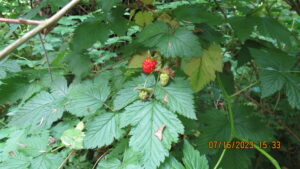
They have an interesting berry in Alaska that looks like a pale raspberry, but the fruit is oblong and larger. It’s called a salmonberry. They lined a few of the trails we hiked and produce tasty berries in July.
One of our bushwhacking guides told us how to identify the salmonberry plant. Notice the 5 leaves on the stem.
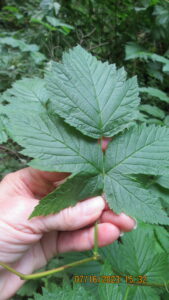
If you can bend the top leaf down and make a butterfly, they are the edible salmonberry.

If not, they are poisonous.
We need to leave space—a habitat—for these wild animals and plants in the world. This is the main benefit of national and state preserves and parks, in my mind. Humans don’t need to inhabit all the spaces on earth and bend them to their will.
The second benefit of national and state preserves and parks is for we humans to enjoy the peace and quiet of nature. And of course, to see the wild animals. Just don’t approach them. Back away slowly, keeping eye contact.
Thanks for stopping by Camping with Five Kids. Have a beautiful holiday season. Merry Christmas! I’ll “see” you in the New Year. Enjoy!


Taking your children to experience the world of nature can show them that there is life beyond their cell phone,
This is SOOOO true, Bill. Thank you for sharing this insight here at Camping with Five Kids. Have a beautiful Christmas!